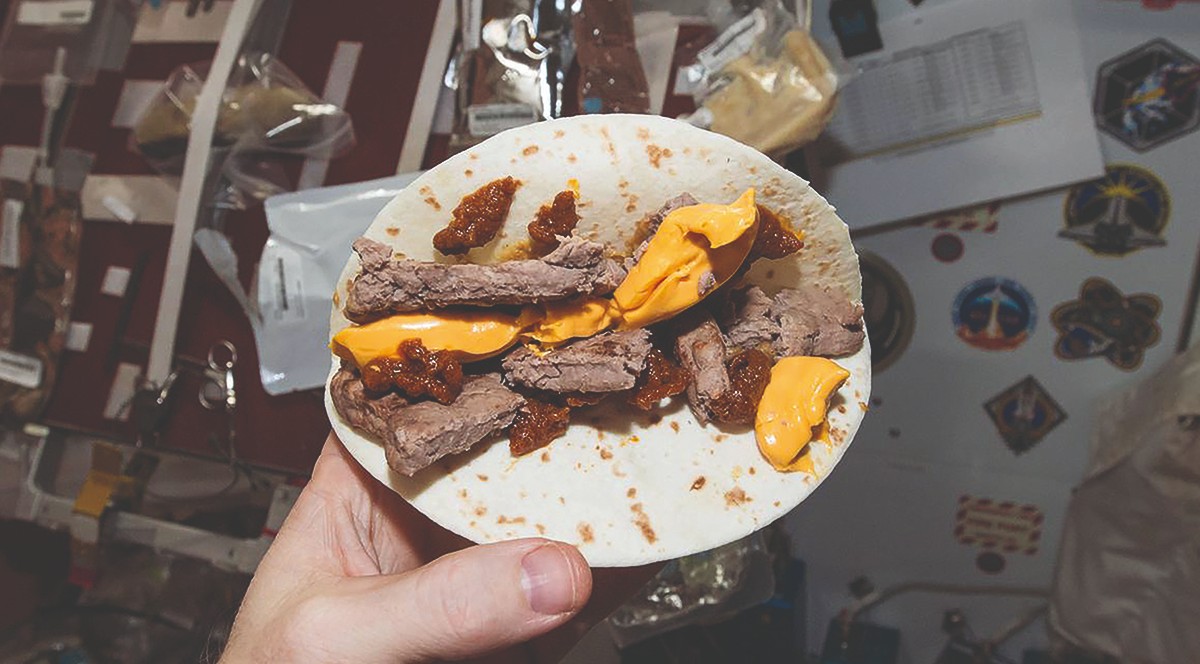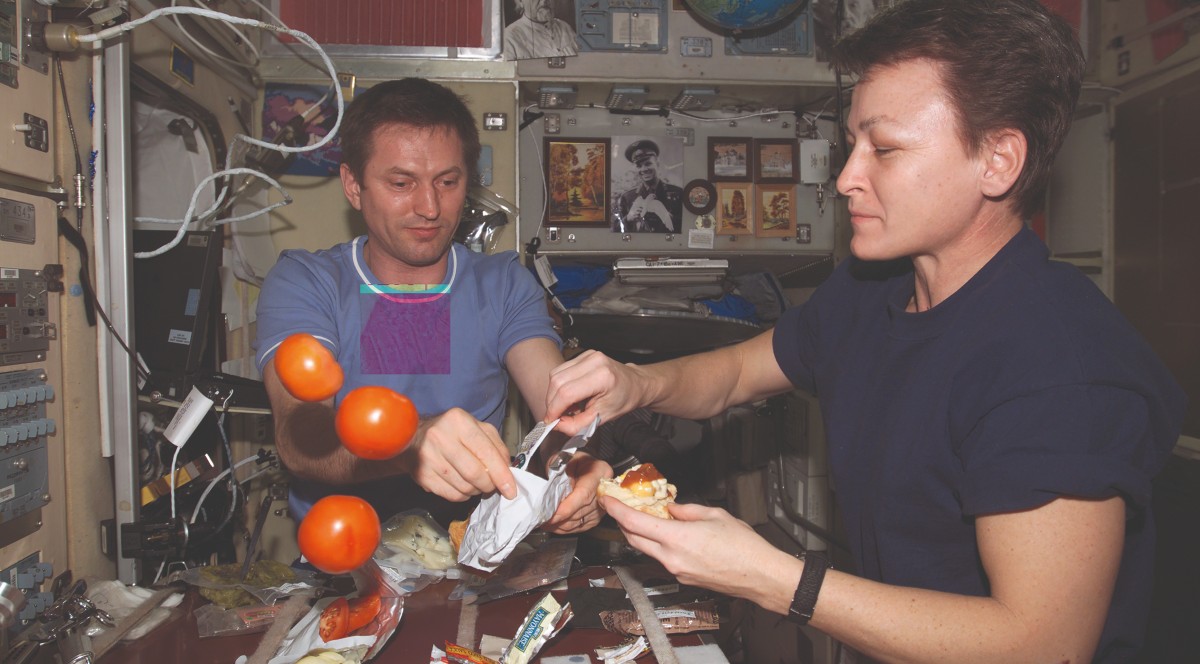The first meal astronauts eat before venturing into space is traditionally a breakfast of steak and eggs. It’s one of NASA’s many food traditions, but for this particular breakfast at least, there was science behind the menu choice.
Steak and eggs washed down with orange juice, and notably, tea was served to the first American in space, Alan Shepard, on May 5, 1961, before his launch in Freedom 7. According to the NASA archive (opens in new tab), no coffee was allowed 24 hours before the flight, as it might have kept Shepard awake, and he still wasn’t allowed any at breakfast because of its diuretic properties. The menu was designed by Beatrice Finkelstein of the Aerospace Medical Laboratory and contained little fiber to be “low residue,” (which in medical parlance means fewer, smaller bowel movements.)
Shepard’s flight time was only 15 minutes, so he didn’t need to eat anything while in space. But a few weeks before, Yuri Gagarin was the first person to do just that during his 108-minute flight, sucking beef and liver paste from a tube. Before Gagarin’s flight, scientists weren’t sure if swallowing in zero gravity was even possible. During the decades that followed, astronauts’ time in space grew into days, months and sometimes years, so the need for both sustenance and sanitation became critical.
Related: Could space greenhouses solve Earth’s food crisis?
The Apollo missions provided not only a giant leap for humankind but also one for gastronomy when NASA invented the spoon-bowl pack for flights to the moon. These plastic bags contained dehydrated food that was reconstituted by adding hot water via a valve.
An article in Nutrition Today magazine (opens in new tab) from 1969 quoted one NASA scientist saying: “The variety was satisfactory, and there was enough to satisfy their hunger and maintain their performance.” However, that’s hardly a ringing endorsement of space food’s taste. “No one goes to space for the food… but the views are amazing,” pace shuttle astronaut Don Thomas, told our sister publication All About Space magazine. Thomas flew four shuttle missions in the 1990s, totaling 44 days in orbit. “Space food is a lot like camping food. It’s freeze-dried or irradiated.”
Cooking in space still often means injecting hot water into a pouch, though the space shuttle had a small convection oven that blew hot air over the irradiated meals to heat them up. The International Space Station (ISS) now has an induction oven.
(opens in new tab)
Scientists have realized food is more than just fuel for astronauts — it plays a vital role in their mental wellbeing and can be a reminder of home. “We were allowed to carry a snack to the launch pad in case of things like weather delays,” Thomas said. “My favorite food is pizza, so I said, ‘can you make me a pizza instead?’ And NASA did. “I think it was the first pizza ever flown in space.”
In 2016, U.K. astronaut Tim Peake famously took his favorite food to space: a bacon sandwich created by chef Heston Blumenthal. Bread can be particularly tricky in zero gravity, as it can leave crumbs that can interfere with sensitive equipment, so many astronauts today choose flatbreads and tortillas.
Astronaut Terry Virts even created his own “space cheeseburger,” putting a beef patty, cheese, tomato paste and Russian mustard in a tortilla wrap. With the ISS came more room, better support facilities and longer mission times, so food became better and more varied. Astronauts now get regular fresh food deliveries, as well as harvest from a few crops like lettuce.

(opens in new tab)
Special orders
Certain culinary considerations have to be made in space.
Tea and coffee
There’s no separate way to add creamer, sugar or sweetener to your hot beverage of choice in space, so every astronaut on the ISS has to let the food science team know how they like their drink before launch. All the astronaut has to do is add hot water.
Salt and pepper
Salt and pepper have to be in liquid form, or people could breathe it in or it could get in their eyes. The salt is dissolved in water and the pepper in a food-grade oil.
Cutlery in space
Each astronaut gets their own utensil pack featuring a knife, fork, spoon and scissors. Most astronauts find the spoon and the scissors the most useful. There’s no kitchen sink or dishwasher — utensils are cleaned with wipes after eating.
Chilled out
There’s no food freezer on the ISS, but there is MERLIN. This cooler is designed for science experiments and provides a temperature-controlled environment between minus 4 degrees Fahrenheit (minus 20 degrees Celsisu) and 119.3 degrees F (48.5 degrees C), but the crew can also use it for chilling drinks and foods.
Hot sauce makes everything taste better in space

(opens in new tab)
While the choice of refreshments for astronauts has grown considerably in recent years, they continue to crave the spicier things in life — specifically, hot sauce. Since the 1960s astronauts have noted that their taste buds don’t work as effectively in space, and it’s not uncommon for astronauts to find themselves enjoying cuisines in space that they couldn’t eat at home, and vice versa. As such, a lot of work has gone into researching the science behind this and coming up with meals that satisfy the astronauts’ hunger as well as enjoyment of the food itself.
Despite the continually updated menus and food choices, nothing seems to beat a good spicy sauce, or really any condiment that can add that extra kick of flavor. Former astronaut Peggy Whitson once wrote in her journal (opens in new tab) that her crew motto while on the ISS was: “It’s all about the sauce.” She went on to say that a common question at lunch or dinner is “What are you having with your sauce today?”
But what causes this loss of taste that so many astronauts experience in space?
It’s thought that due to the lack of gravity, bodily fluids normally drain down to our legs and become equally distributed around the body. This can lead to fluids building up in the head and blocking the nasal passages, similar to the congestion you can experience when you catch a cold.
As approximately 80% of the flavors, we taste actually come from what we smell, this congestion could explain why astronauts cannot taste the same flavors that they can on Earth.
Another theory is that the ISS is filled with a whole range of strange smells, from body odor to sterile equipment. These aromas could distract the astronauts from smelling their own food effectively and getting the most out of the flavor. Either way, it looks like fiery and well-seasoned cuisine is essential for keeping astronauts well fed and happy.
Fancy space tipple? Not on NASA’s watch.
Booze is strictly forbidden on the ISS for a whole number of reasons. An inebriated astronaut in control of a billion-dollar space station hurtling through space isn’t a very good idea, but alcohol can also damage the ISS in other ways. Alcohol-containing products such as mouthwash and hand sanitizer are also banned, as the alcoholic compounds they contain affect the station’s water-recovery system. Ethanol is a volatile compound and could cause damage to valuable equipment on the ISS.
Despite the dangers of alcohol in space, it wasn’t always taboo. At the start of the space race, alcoholic drinks were included in cosmonaut rations. Small amounts of cognac were said to be recommended by Russian doctors to help the immune system. The ban only led to more inventive ways to sneak it aboard.
Chris Carberry details the various smuggling methods, as described by former cosmonauts and astronauts, in his book “Alcohol in Space: Past, Present and Future (opens in new tab).” Alcohol was smuggled in hollowed-out books, “mislabeled” juice cartons and even in pouches in spacesuits.
Today alcohol is deliberately sent to the ISS for science, although not opened. In 2021, bottles of red wine returned to Earth after being stored on the ISS for over a year. Upon their return to Earth, they were compared with bottles that had not been sent to space. Scientists compared them, suggesting that wine in space may age faster. More alcohol-based experiments are planned to be carried out, including investigating the effect of microgravity on grapevine growth, as well as the effects on bacteria, yeast and fermentation processes.
The controversial and dangerous sandwich
Alcohol isn’t the only banned substance that has been covertly transported into space. In 1965, John Young smuggled a corned- beef sandwich on the first crewed Gemini flight, Gemini 3, much to the surprise of his crewmate Gus Grissom.
Just before launch on March 23, 1965, Young had hidden the sandwich in the pocket of his spacesuit. After Grissom enjoyed a quick bite of the sandwich during their flight, he quickly decided to put it in his pocket as it began to break up. According to the Gemini 3 transcript, Young suggested that the sandwich was “a thought… not a very good one,” to which Grissom replied: “Pretty good, though, if it would just hold together.” Corned beef later made an official appearance on the menu of the first space shuttle mission in 1981, of which Young was the commander.
Additional resources
For more about the life on the International Space Station (ISS) visit NASA’s dedicated webpage (opens in new tab). Also, check out the “The Astronaut’s Cookbook: Tales, Recipes, and More (opens in new tab)” by Charles T. Bourland for more about making food in space.
Bibliography
- William Gurstelle, “Beatrice Finkelstein, the Woman Who Fed the Astronauts (opens in new tab)“, Scientific American, March 2021.
- William K. Douglas, “Flight Surgeon’s Report for Mercury-redston Missions 3 and 4 (opens in new tab)“, NASA, accessed May 2022.
- Malcolm Smith & Charles Berry, “Dinner on the Moon (opens in new tab)“, Nutrition Today, Volume 4, 1969.
- Nanoracks, “Zero G Oven (opens in new tab)“, accessed May 2022.
- Royal Museums Greenwich, “What do astronauts eat in space? (opens in new tab)“, accessed May 2022.
- Tom Lamont, “Heston, we have a problem… the top chef cooks for Tim Peake (opens in new tab)“, BBC, March 2016.
- NASA, “What Are JPL’s Lucky Peanuts? (opens in new tab)“, October 2021.
- NASA, “Salt and Pepper Dispensers (opens in new tab)“, accessed May 2022.
- Bryan Lufkin, “Why astronauts are banned from getting drunk in space (opens in new tab)“, BBC, February 2017.
- Space Cargo Unlimited, “Space Cargo Unlimited reveals the first results of the scientific research carried out on wine that aged more than one year on board the ISS, as part of Mission WISE (opens in new tab)“, March 2021.

